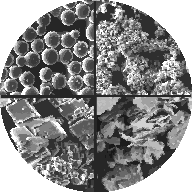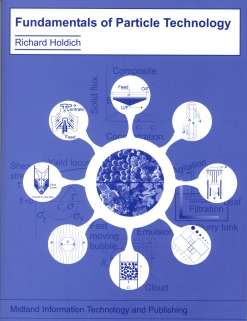Particle characterisation - Chapter 2
Particle size distributions
Figure 2.13, Malvern Particle Size Distribution - Expanded view of the
Malvern instrument printout, as shown on page 17 of Fundamentals. Note the mean size D(4,3) is quoted as 44.11 microns
and the D(3,2) - also know as the Sauter mean diameter is shown to be 8.52 microns in the "Results Statistics"
section above the table of data.These average particle size values can be
compared with what is obtained when the full particle size data is put into a spreadsheet
and the D(4,3) and D(3,2) calculated manually, as illustrated in the spreadsheet below.
Table 2.3, Malvern Particle Size Distribution - Excel spreadsheet for data used in
Figure 2.13. The spreadsheet calculation matches the values shown on the printout, Figure 2.13. Note, the data is a volume, same as a
mass, distribution and not a number distribution. This is mentioned next to "Distribution Type" in the Results Statistics section.
Particle size analysis equipment - selection by expert system
Amendments and corrections
In the book Fundamentals of Particle Technology:
Page 11: The equation for the Normal Distribution, inside the exponential
term, should read -(x-x50)2 and not -x-x50
Also, this is the equation for the Normal probability density function, which is not really the same as n3(x) but it is proportional to it.
Page 15: BS reference should read BS 3625,
which is for the graticule. See also BS 3406 for the method.
Page 173: Please add Sauter mean diameter to the index - refering the reader to page 13.
Particle Size Distribution explanation
The video below explains the meanings behind the various different output data from a typical particle size
analysis by a modern instrument. The printout is from a Malvern laser diffraction device and is Figure 2.13
in the book Fundamentals of Particle Technology, see above for more details and a jpg file of the data.
Answers to problems at the end of Chapter 2:
Exercise 2.1, equivalent spherical diameters by - answers:
perimeter is 12.7 microns
projected area is 11.3 microns
surface area is 13.8 microns
volume is 12.4 microns
specific surface is 10 microns
mesh size is 10 microns
Note practically all the diameters are different! So, we have a different
equivalent diameter depending on which equivalent we wish to use. This
is one reason for confusion in Particle Technology, which one should we use?
The answer is, we should use the one that is most appropriate to the end
use of the data; e.g. projected area for a paint pigment, a settling diameter
for a gravity settling design, etc.
Answers to problems:
Q1 and Q2 see table
Q3: correct answer is (b), see table for details
Q4: correct answer is (d), see table for details
Q5: correct answer is (c), see table for details
and 2.64x105 m-1
Q6
(i): correct answer is (c)
(ii): correct answer is (b)
(iii): horizontal line at y=1/100 between x=1 and x=101, giving an
area of one in accordance with Figure 2.7
(iv): correct answer is (c), but (a) is also correct but not the best one to use
as the constants can be cancelled out
(v): correct answer is (d)
(vi): 7.9x104 m-1
(vii): The surface area will be greater than that calculated assuming that the particles are
spheres. Sphericity is surface area of spheres of equivalent volume divided by
true surface area of particles (and fractional for everything other than a sphere).
So, you need to divide the calculated specific suface (for spheres) by the value
of the sphericity (a fractional value) to give the true specific surface
for our non-spherical particles.
Q7
This follows a similar solution to Q6, except when coming to calculate the
specific surface you need to use the mass distribution equation at the top of
page 19 (it's the second one down). So, in fact, it is an easier calculation
to work out specific surface from a mass distribution compared to a number distribution:
you only need to do one integration!
(i): correct answer is (c)
(ii): correct answer is (b)
Q8
(i): in order:
n0(x)=0.043/x
n0(x)=0.239/x
n0(x)=0.304/x
(ii): correct answer is (a)
(iii): correct answer is (c)
(iv): correct answer is (b)
(v): 2.27x105 m-1
If you have difficulty with this conversion try this fiddle:
if the answer was 2.27 microns, and not inverse microns,you probably wouldn't have
any difficulty in the conversion - it would be 2.27 multiplied by 10-6 m.
Now, as this is inverse microns, and not microns, you must do the opposite!
(vi): correct answer is (a)
FAQ
Particle size equipment suppliers
For an up-to-date list of particle size equipment suppliers please use the Google link below:Google search for particle sizing equipment suppliers

